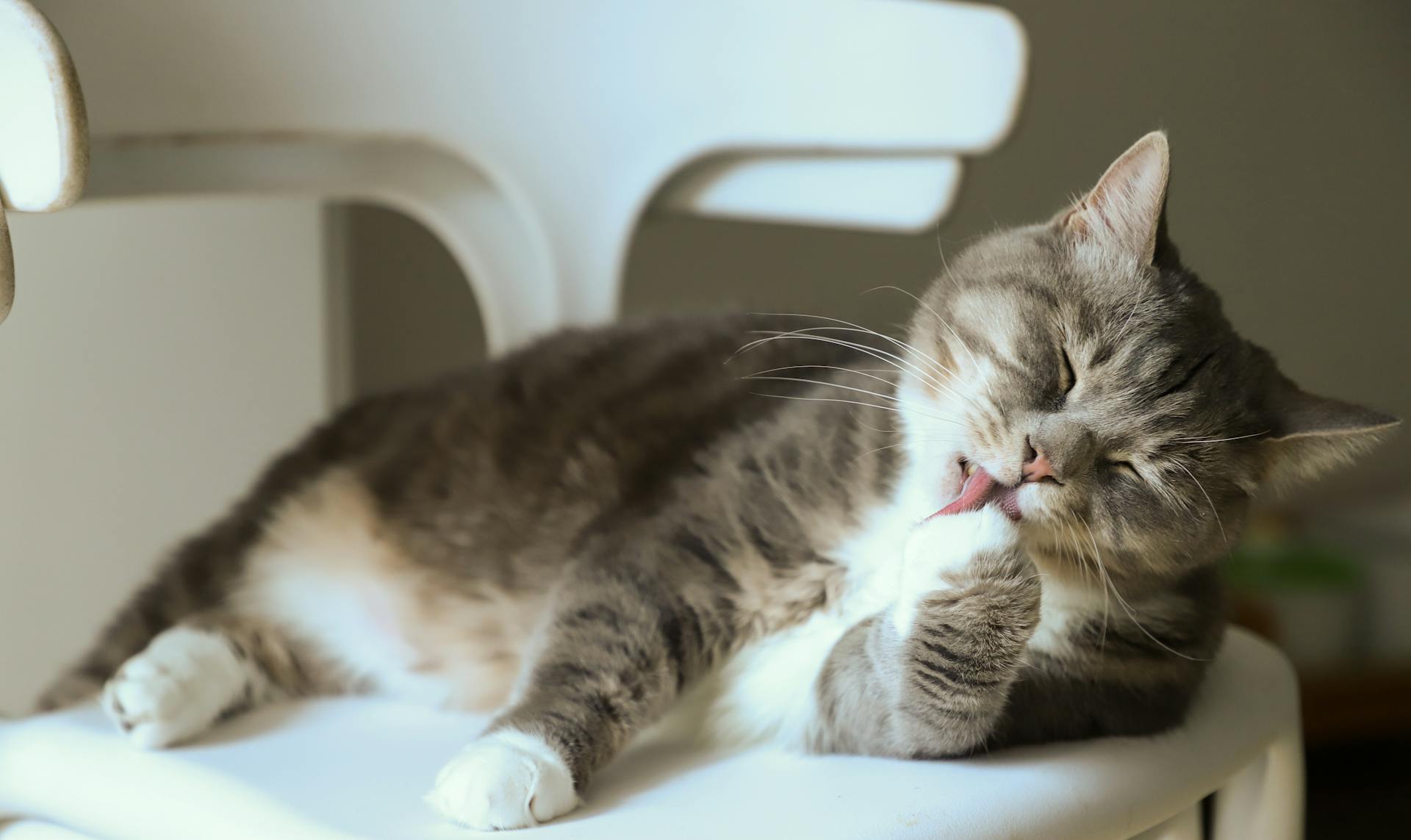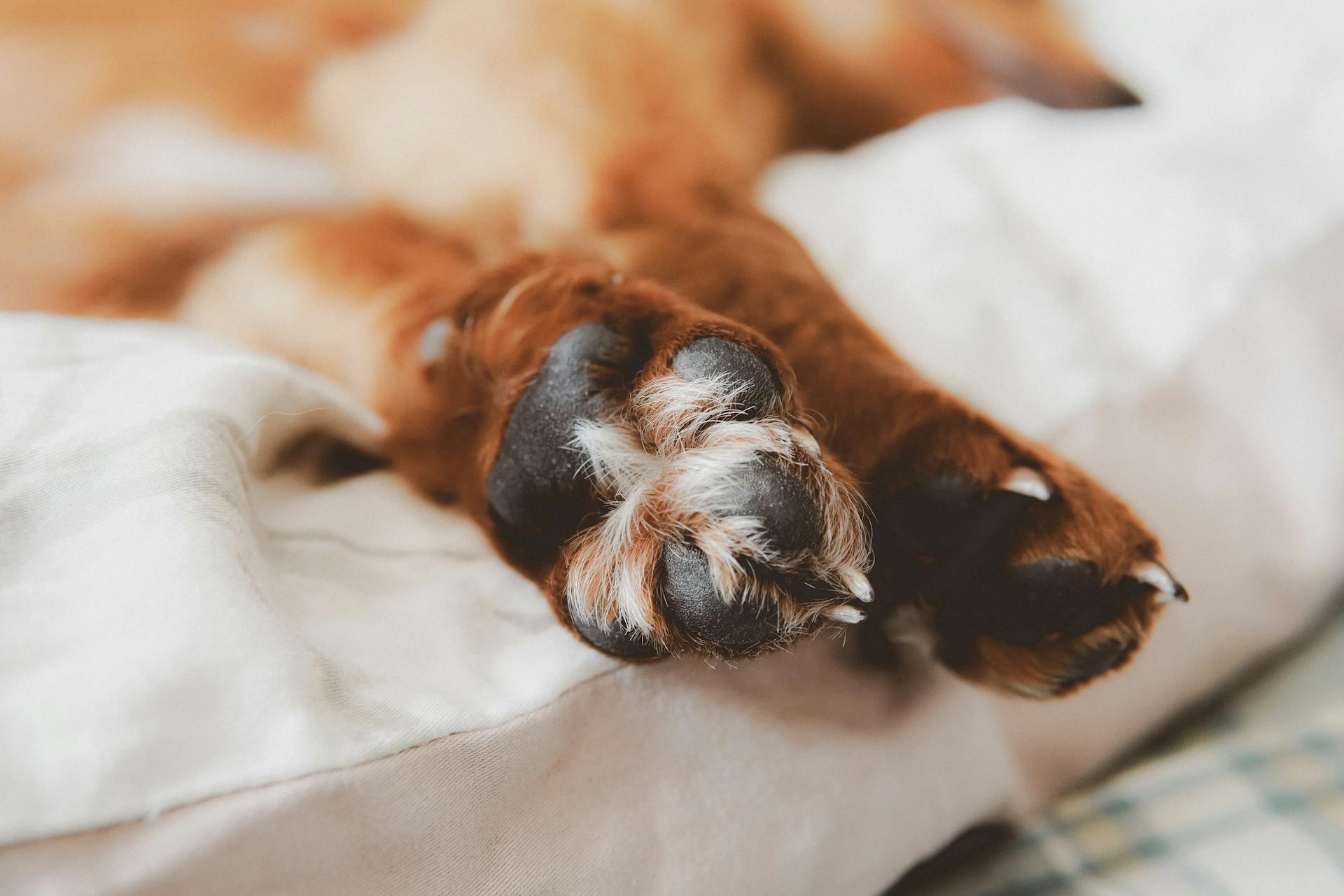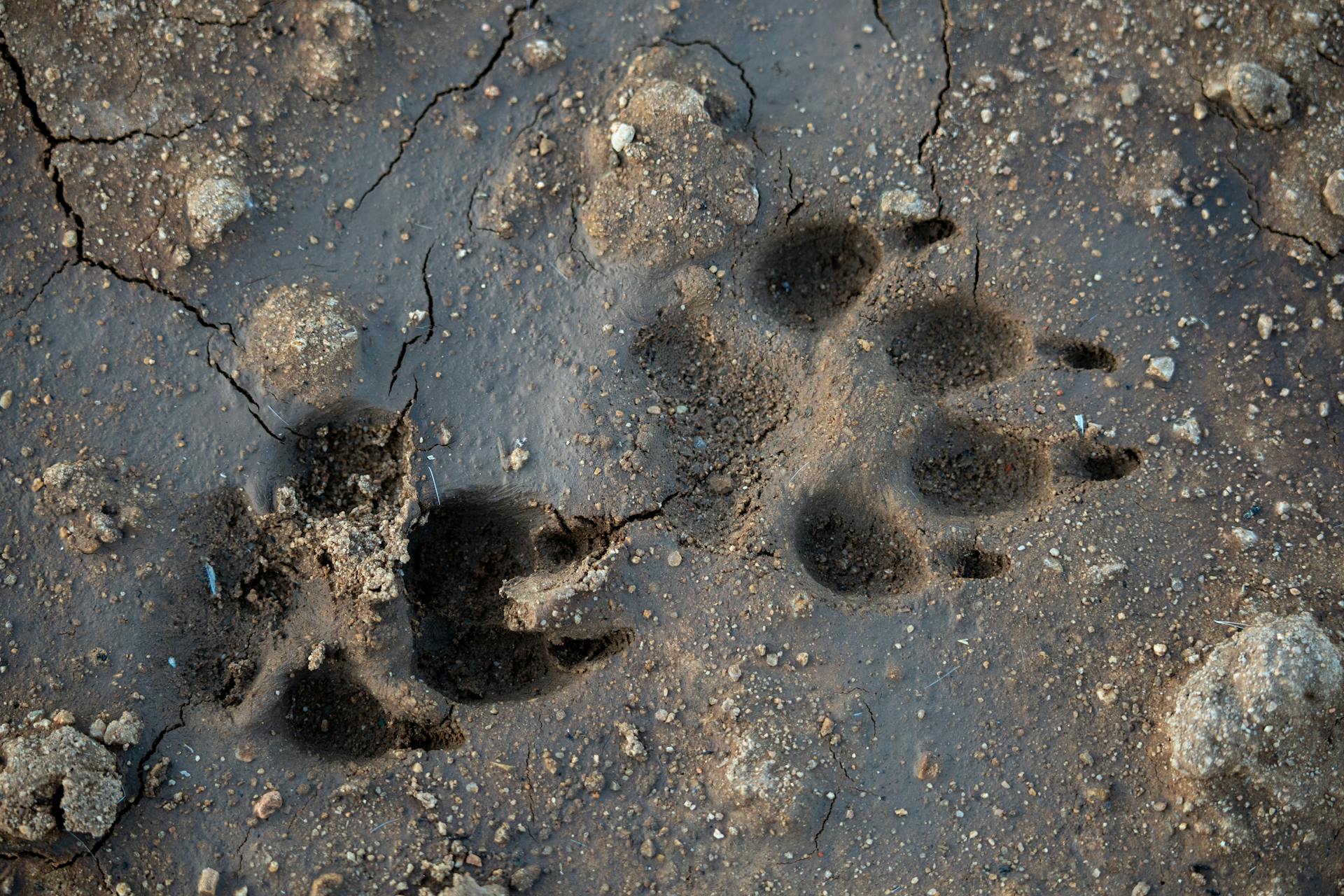
Rough dog paws can be a real challenge for dog owners who love to hike with their furry friends. Thick calluses on a dog's paw pads can make it difficult for them to walk, run, and even stand comfortably.
Dry skin and cracks are common issues that can occur on a dog's paw pads, especially in cold or dry weather. This is because the skin on a dog's paws is thin and sensitive.
Regular trimming of your dog's nails is essential to prevent overgrowth, which can put pressure on the paw pads and cause discomfort. Keep in mind that overgrown nails can also lead to lameness and arthritis in dogs.
A good rule of thumb is to trim your dog's nails every 4-6 weeks to maintain a healthy length.
Readers also liked: Should I Wet My Dogs Dry Food
Causes and Prevention
Dry, cracked paws in dogs can be caused by cold and dry weather conditions, exposure to hot surfaces, or even salt in the winter months.
Allergic reactions can also lead to dry cracked paws, whether it's due to food, environmental factors, or chemicals in grooming products.
Nutritional deficiencies can result in dryness and cracking of the paw pads, so it's essential to provide your dog with a balanced diet.
Medical conditions can also be a culprit behind rough dog paws, so if you suspect something is amiss, consult your veterinarian.
Over-grooming can strip the natural oils from your dog's paw pads, making them more prone to dryness and cracking.
Here are some common causes of dry, cracked paws in dogs:
- Cold and dry weather conditions
- Exposure to hot surfaces
- Salt in the winter months
- Allergic reactions
- Nutritional deficiencies
- Medical conditions
- Over-grooming
Preventing rough dog paws requires a multi-faceted approach, including protecting your dog's paws from extreme temperatures, using paw balms or creams to lock in moisture, and avoiding over-grooming.
Symptoms and Signs
Dogs are good at masking discomfort, so it's up to you to look for subtle signs of irritated paws.
Dry paws can cause the paw pads to crack or peel, making them a clear sign of irritation.
Cracked paw pads can be a result of dry paws, which may also lead to discomfort for your dog.
Rough surfaces on the paw pads can be a sign of dryness, and may feel scaly to the touch.
Discomfort is a common symptom of dry paw pads, and may cause your dog to lick or chew at their paws.
Licking or chewing paws can be a sign of irritated paws, and may result in more irritation and dryness.
Redness or irritation is another sign of dry paw pads, and may be accompanied by blisters or sores in severe cases.
Here are some common signs of irritated paws to look out for:
- Cracked paw pads
- Rough surfaces on the paw pads
- Discomfort
- Redness or Irritation
- Licking or chewing paws
- Blisters or sores
Treatment and Remedies
Rough dog paws can be a real pain for both you and your furry friend. Dry, cracked, and rough paws are common in dogs and can be caused by a number of factors, including hot pavement, salt and sand, and certain chemicals.
Applying a balm to your dog's paws can help soothe them and ease any irritation. Look for a balm specifically designed for dogs, made with natural ingredients like beeswax, shea butter, and coconut oil.
Some great natural ingredients for dog paws include almond oil, jojoba oil, apricot kernel oil, coconut oil, and olive oil. These oils penetrate deeply into the skin and are rich in omega fatty acids, vitamins, and minerals essential for healthy skin and coat.
Here are some ingredients to look for in a paw balm:
- Full-spectrum hemp extract: Supports a healthy inflammatory response and promotes skin health
- Coconut oil: Supports skin health
- Mango butter: Promotes healthy skin on your dog's pads
- Beeswax: Promotes the body's innate resistance to pathogens
Trim Excess Fur
Trimming excess fur around your dog's paws is a simple yet effective way to prevent irritation and dryness. Excess hair can trap dirt and debris, leading to these issues.
Regular trimming can help keep your dog's paws clean and healthy. Using a pair of scissors or clippers is a good way to trim the hair around your dog's paw pads.
Be careful not to cut the skin when trimming the hair around your dog's paws.
For your interest: Short Haired Chorkie
Natural Remedies for Dry Skin

Dry skin on your furry friend can be a real pain - literally. Natural remedies can be a great way to soothe and moisturize their dry paws.
Paw balms are a popular natural remedy for dry dog paws. Look for a balm specifically designed for dogs, as human lotions can be harsh on their skin. Earth Buddy's Paw & Skin Balm is a great option, formulated with organic butters and botanical extracts to maintain skin moisture.
You can also try using natural oils like almond oil, jojoba oil, apricot kernel oil, coconut oil, and olive oil. These oils penetrate deeply into the skin, providing essential nutrients for healthy skin and coat.
If your dog's paws are already dry and cracked, gentle cleaning and moisturizing can help. Soak the affected area with a dilute antiseptic, dry the pad with a clean towel, and apply an antibiotic topical ointment. Be sure to check for any signs of infection or pain.
On a similar theme: Can Great Pyrenees Sleep outside

Some great natural ingredients to look for in paw balms and oils include beeswax, shea butter, coconut oil, and full-spectrum hemp oil. These ingredients can help promote skin health, reduce inflammation, and even provide pain relief.
Here are some natural remedies you can try to bring your dog's paws back to life:
* Almond oilJojoba oilApricot kernel oilCoconut oilOlive oil
Remember to always check with your veterinarian before trying any new remedies, especially if your dog has a sensitive skin or allergies.
Additional reading: Home Remedies for Rough Dog Paws
Care and Maintenance
Rough dog paws are a common issue many pet owners face, especially during extreme weather conditions. Regularly checking your dog's paws is essential to prevent injuries and discomfort.
You should be extra patient with your dog when walking during the winter if they're not used to the weather. If you had to go outside in sub-freezing temperatures to go to the bathroom, you might be a little upset about it too!
Suggestion: Doberman Pinscher Cold Weather
To keep your dog's paws clean, regularly wipe them with a damp cloth or baby wipes to remove dirt and debris. This will help prevent irritation and promote healthy paws.
Grooming your dog's paws is crucial to prevent injuries and discomfort. Brush the hair between their paw pads to prevent matting and pain. You should also check between paw pads regularly and clean out any debris that may have accumulated.
De-icing products can make your dog's paws blister or burn, so consider using booties for protection. If your dog's paws are already damaged, try applying a balm to soothe them and ease any irritation.
Here are some natural remedies you can try to bring your dog's paws back to life:
- Epsom salt soaks can help soften your dog's paw pads
- Moisturizing paw balms can help keep your dog's paws moisturized
- Full-spectrum hemp oil, coconut oil, and mango butter can provide support for healthy skin
Remember to always consult with your vet before trying any new remedies or products, especially if your dog has sensitive skin.
Protection and Preparation
As a dog owner, it's essential to protect your furry friend's paws from extreme temperatures and harsh surfaces. Temperatures that are too hot or cold can cause your dog's paws to crack or blister, so it's crucial to provide protection.
To prepare your dog's paws for the outdoors, start by introducing them to short periods of time outside and gradually increase play or walk time to help their paws adjust to the environment. This will help make their paws more durable.
If you live in an area with snow, limit the time your dog's paws are in the snow or consider using boots to protect their paws from the cold, sharp ice, rock salt, and other harmful substances.
You can check if the ground is too hot for your dog's paws by placing your palm on the ground for five seconds. If the temperature is too hot to keep your hand there for the full five seconds, it's too warm for your dog's paws.
Consider using dog booties for your dog's feet if their paws are especially delicate or if you live in an area with extreme weather conditions. Dog booties can protect paws and prevent further dryness by keeping your dog's feet warm and dry.
Here are some steps to help your dog get accustomed to wearing dog booties:
- Introduce the booties gradually by allowing your dog to sniff them, then place one on their feet for a few seconds and remove it.
- Reward positive behavior by praising and rewarding your dog when they allow you to put the booties on.
- Increase the duration by gradually increasing how long they wear the booties.
- Take it slow, as some dogs may need more time to adjust to wearing booties.
Frequently Asked Questions
Should I moisturize my dogs paw pads?
Yes, moisturizing your dog's paw pads is essential to keep them healthy and comfortable. Regular moisturizing helps prevent peeling and cracking, promoting overall paw health.
How to moisturize dog paw pads?
Apply a non-toxic moisturizer like coconut oil, vitamin E cream, or paw balm to your dog's paw pads and between their toes a few times a week to keep them soft and protected. Use a pea-sized amount and rub it in until absorbed for best results.
What texture should dog paws be?
Dog paws can be either smooth or tough and calloused, depending on the dog's lifestyle and environment. A healthy dog paw is typically covered with thick, pigmented skin.
Sources
- https://onlydogsallowed.co.uk/blogs/news/how-to-treat-your-dogs-rough-and-cracked-paws
- https://www.earthbuddypet.com/eb-blog/how-to-help-dry-dog-paws/
- https://www.dogster.com/dog-health-care/how-to-protect-dog-paws
- https://vetericyn.com/blog/how-to-treat-and-prevent-cracked-dog-paws/
- https://www.thesprucepets.com/best-ways-to-soften-your-dog-paws-5224677
Featured Images: pexels.com


